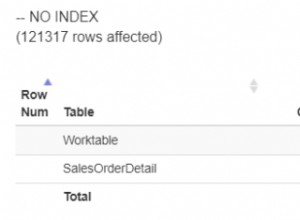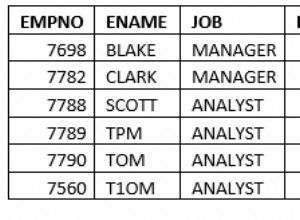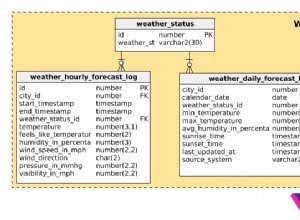योजना
सेटअप
drop table if exists calendar_t;
CREATE TABLE calendar_t (
id integer primary key auto_increment not null,
`date` date not null,
day varchar(9) not null,
month varchar(13) not null,
`year` integer not null
);
drop view if exists digits_v;
create view digits_v
as
select 0 as n
union all
select 1
union all
select 2
union all
select 3
union all
select 4
union all
select 5
union all
select 6
union all
select 7
union all
select 8
union all
select 9
;
insert into calendar_t
( `date`, day, month, `year` )
select
date_add('2015-01-01', interval 100*a2.n + 10*a1.n + a0.n day) as `date`,
dayname(date_add('2015-01-01', interval 100*a2.n + 10*a1.n + a0.n day)) as day,
monthname(date_add('2015-01-01', interval 100*a2.n + 10*a1.n + a0.n day)) as month,
year(date_add('2015-01-01', interval 100*a2.n + 10*a1.n + a0.n day)) as `year`
from
digits_v a2
cross join digits_v a1
cross join digits_v a0
order by date_add('2015-01-01', interval 100*a2.n + 10*a1.n + a0.n day)
;
drop table if exists example;
create table example
(
`date` date not null,
status varchar(23) not null
);
insert into example
( `date`, status )
values
( '2015-06-01', 'Start' ),
( '2015-06-03', 'Stage 2' ),
( '2015-06-07', 'Stage 3' )
;
क्वेरी
select cal_date, mdate, ex2.status
from
(
select cal_date, max(ex_date) as mdate
from
(
select cal.`date` as cal_date, ex.`date` as ex_date
from calendar_t cal
inner join example ex
on ex.`date` <= cal.`date`
) maxs
group by cal_date
) m2
inner join example ex2
on m2.mdate = ex2.`date`
-- pick a reasonable end date for filtering..
where cal_date <= date('2015-06-15')
order by cal_date
;
आउटपुट
+------------------------+------------------------+---------+
| cal_date | mdate | status |
+------------------------+------------------------+---------+
| June, 01 2015 00:00:00 | June, 01 2015 00:00:00 | Start |
| June, 02 2015 00:00:00 | June, 01 2015 00:00:00 | Start |
| June, 03 2015 00:00:00 | June, 03 2015 00:00:00 | Stage 2 |
| June, 04 2015 00:00:00 | June, 03 2015 00:00:00 | Stage 2 |
| June, 05 2015 00:00:00 | June, 03 2015 00:00:00 | Stage 2 |
| June, 06 2015 00:00:00 | June, 03 2015 00:00:00 | Stage 2 |
| June, 07 2015 00:00:00 | June, 07 2015 00:00:00 | Stage 3 |
| June, 08 2015 00:00:00 | June, 07 2015 00:00:00 | Stage 3 |
| June, 09 2015 00:00:00 | June, 07 2015 00:00:00 | Stage 3 |
| June, 10 2015 00:00:00 | June, 07 2015 00:00:00 | Stage 3 |
| June, 11 2015 00:00:00 | June, 07 2015 00:00:00 | Stage 3 |
| June, 12 2015 00:00:00 | June, 07 2015 00:00:00 | Stage 3 |
| June, 13 2015 00:00:00 | June, 07 2015 00:00:00 | Stage 3 |
| June, 14 2015 00:00:00 | June, 07 2015 00:00:00 | Stage 3 |
| June, 15 2015 00:00:00 | June, 07 2015 00:00:00 | Stage 3 |
+------------------------+------------------------+---------+
संदर्भ




